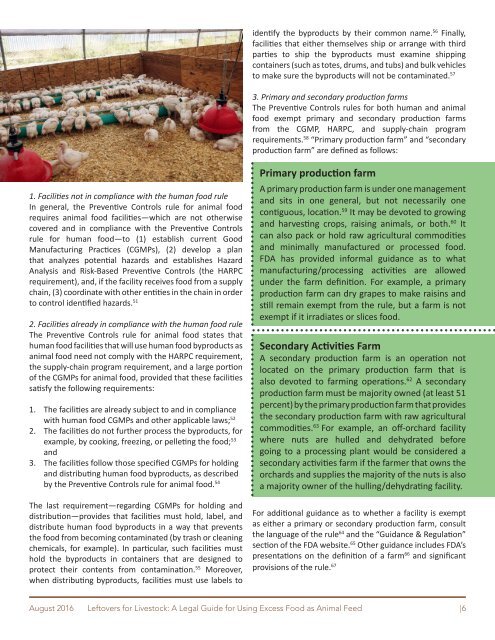LEFTOVERS FOR LIVESTOCK
Leftovers-for-Livestock_A-Legal-Guide_August-2016
Leftovers-for-Livestock_A-Legal-Guide_August-2016
Create successful ePaper yourself
Turn your PDF publications into a flip-book with our unique Google optimized e-Paper software.
identify the byproducts by their common name. 56 Finally,<br />
facilities that either themselves ship or arrange with third<br />
parties to ship the byproducts must examine shipping<br />
containers (such as totes, drums, and tubs) and bulk vehicles<br />
to make sure the byproducts will not be contaminated. 57<br />
3. Primary and secondary production farms<br />
The Preventive Controls rules for both human and animal<br />
food exempt primary and secondary production farms<br />
from the CGMP, HARPC, and supply-chain program<br />
requirements. 58 “Primary production farm” and “secondary<br />
production farm” are defined as follows:<br />
1. Facilities not in compliance with the human food rule<br />
In general, the Preventive Controls rule for animal food<br />
requires animal food facilities—which are not otherwise<br />
covered and in compliance with the Preventive Controls<br />
rule for human food—to (1) establish current Good<br />
Manufacturing Practices (CGMPs), (2) develop a plan<br />
that analyzes potential hazards and establishes Hazard<br />
Analysis and Risk-Based Preventive Controls (the HARPC<br />
requirement), and, if the facility receives food from a supply<br />
chain, (3) coordinate with other entities in the chain in order<br />
to control identified hazards. 51<br />
2. Facilities already in compliance with the human food rule<br />
The Preventive Controls rule for animal food states that<br />
human food facilities that will use human food byproducts as<br />
animal food need not comply with the HARPC requirement,<br />
the supply-chain program requirement, and a large portion<br />
of the CGMPs for animal food, provided that these facilities<br />
satisfy the following requirements:<br />
1. The facilities are already subject to and in compliance<br />
with human food CGMPs and other applicable laws; 52<br />
2. The facilities do not further process the byproducts, for<br />
example, by cooking, freezing, or pelleting the food; 53<br />
and<br />
3. The facilities follow those specified CGMPs for holding<br />
and distributing human food byproducts, as described<br />
by the Preventive Controls rule for animal food. 54<br />
The last requirement—regarding CGMPs for holding and<br />
distribution—provides that facilities must hold, label, and<br />
distribute human food byproducts in a way that prevents<br />
the food from becoming contaminated (by trash or cleaning<br />
chemicals, for example). In particular, such facilities must<br />
hold the byproducts in containers that are designed to<br />
protect their contents from contamination. 55 Moreover,<br />
when distributing byproducts, facilities must use labels to<br />
Primary production farm<br />
A primary production farm is under one management<br />
and sits in one general, but not necessarily one<br />
contiguous, location. 59 It may be devoted to growing<br />
and harvesting crops, raising animals, or both. 60 It<br />
can also pack or hold raw agricultural commodities<br />
and minimally manufactured or processed food.<br />
FDA has provided informal guidance as to what<br />
manufacturing/processing activities are allowed<br />
under the farm definition. For example, a primary<br />
production farm can dry grapes to make raisins and<br />
still remain exempt from the rule, but a farm is not<br />
exempt if it irradiates or slices food.<br />
Secondary Activities Farm<br />
A secondary production farm is an operation not<br />
located on the primary production farm that is<br />
also devoted to farming operations. 62 A secondary<br />
production farm must be majority owned (at least 51<br />
percent) by the primary production farm that provides<br />
the secondary production farm with raw agricultural<br />
commodities. 63 For example, an off-orchard facility<br />
where nuts are hulled and dehydrated before<br />
going to a processing plant would be considered a<br />
secondary activities farm if the farmer that owns the<br />
orchards and supplies the majority of the nuts is also<br />
a majority owner of the hulling/dehydrating facility.<br />
For additional guidance as to whether a facility is exempt<br />
as either a primary or secondary production farm, consult<br />
the language of the rule 64 and the “Guidance & Regulation”<br />
section of the FDA website. 65 Other guidance includes FDA’s<br />
presentations on the definition of a farm 66 and significant<br />
provisions of the rule. 67<br />
August 2016 Leftovers for Livestock: A Legal Guide for Using Excess Food as Animal Feed |6


